
John Diamond (dancer)
Encyclopedia

Irish American
Irish Americans are citizens of the United States who can trace their ancestry to Ireland. A total of 36,278,332 Americans—estimated at 11.9% of the total population—reported Irish ancestry in the 2008 American Community Survey conducted by the U.S. Census Bureau...
dancer and blackface
Blackface
Blackface is a form of theatrical makeup used in minstrel shows, and later vaudeville, in which performers create a stereotyped caricature of a black person. The practice gained popularity during the 19th century and contributed to the proliferation of stereotypes such as the "happy-go-lucky darky...
minstrel
Minstrel show
The minstrel show, or minstrelsy, was an American entertainment consisting of comic skits, variety acts, dancing, and music, performed by white people in blackface or, especially after the Civil War, black people in blackface....
performer. Diamond entered show business at age 17 and soon came to the attention of circus promoter P. T. Barnum
P. T. Barnum
Phineas Taylor Barnum was an American showman, businessman, scam artist and entertainer, remembered for promoting celebrated hoaxes and for founding the circus that became the Ringling Bros. and Barnum & Bailey Circus....
. In less than a year, Diamond and Barnum had a falling-out, and Diamond left to perform with other blackface performers. Diamond's dance style merged elements of English, Irish
Irish dance
Irish dancing or Irish dance is a group of traditional dance forms originating in Ireland which can broadly be divided into social dance and performance dances. Irish social dances can be divided further into céilí and set dancing...
, and African dance. For the most part, he performed in blackface and sang popular minstrel tunes or accompanied a singer or instrumentalist. Diamond's movements emphasized lower-body movements and rapid footwork with little movement above the waist.
Diamond was most famous for a series of challenge dances. He regularly advertised that he could defeat all comers in a dancing contest, and he made good on his boasts. However, Diamond soon came to the attention of the dancer whom Barnum had replaced him with, a young black man known as Master Juba
Master Juba
Master Juba was an African American dancer active in the 1840s. He was one of the first black performers in the United States to play onstage for white audiences and the only one of the era to tour with a white minstrel group...
. Diamond and Juba fought dance-offs through the mid-1840s; records indicate that Juba won all but one. Accordingly, historian Robert Toll calls Diamond the "greatest white minstrel dancer".
Career
In 1840, Diamond won $500 in a New York City jigJig
The Jig is a form of lively folk dance, as well as the accompanying dance tune, originating in England in the 16th century and today most associated with Irish dance music and Scottish country dance music...
competition. Circus proprietor P. T. Barnum
P. T. Barnum
Phineas Taylor Barnum was an American showman, businessman, scam artist and entertainer, remembered for promoting celebrated hoaxes and for founding the circus that became the Ringling Bros. and Barnum & Bailey Circus....
took notice and hired the boy, touring him throughout the United States and Europe. Ever the showman, Barnum claimed that the dancer was a mere 12 years old (he was really 17) and billed him as the "King of Diamonds" in advertisements. Diamond performed solo and as part of a pair with blackface singers and musicians. For a time, he was teamed with "the King of Banjo players, and the Emperor of Extravaganza Singers", Billy Whitlock
Billy Whitlock
William M. "Billy" Whitlock was an American blackface performer. He began his career in entertainment doing blackface banjo routines in circuses and dime shows, and by 1843, he was well known in New York City. He is best known for his role in forming the original minstrel troupe, the Virginia...
. Their advertisements exclaimed, "Second night of the engagement of the little 'Wirginny Nigger,' only 12 years old, who can outdance the nation, and come some 'Heel and Toe Breakdowns,' that are a caution to all darkies, and no mistake!"Vauxhall Gardens
Vauxhall Gardens
Vauxhall Gardens was a pleasure garden, one of the leading venues for public entertainment in London, England from the mid 17th century to the mid 19th century. Originally known as New Spring Gardens, the site was believed to have opened before the Restoration of 1660 with the first mention being...
announcement in the Morning Herald
Morning Herald
The Morning Herald was an early daily newspaper in the United Kingdom.The newspaper was founded in 1780 by the Reverend Sir Henry Bate Dudley, former editor of The Morning Post. It was initially a liberal paper aligned with the Prince of Wales, but later became aligned with the Tories...
, New York, July 18, 1840. Quoted in Nathan 62.
Diamond earned a bad reputation among promoters and managers. One source claimed that his dancing was "considerably better than his temper and disposition." In February 1841, Diamond extorted money from P. T. Barnum and deserted his former mentor to go on a week-long binge of alcohol and women. Barnum sent a letter to his colleagues to caution them against hiring the dancer. Barnum claimed Diamond had "overdrawn the money due him to the amount of $95 and has during the last week expended a hundred dollars in brothels and haunts of dissipation & vice."
Free of Barnum, Diamond played in pairs or groups of three or four blackface performers. In January 1843, he was in a circus with other blackface performers; the program promised "Negro extravaganzas, songs, dances, and locomotive imitations by Whitlock, Diamond, [John] Daniels
John Daniels
John Daniels may refer to:*John C. Daniels, mayor of New Haven, Connecticut*[John Daniel]], Song written by Dolly Parton for the Halos and Horns Album.*John W. Daniels , co-founder of Archer Daniels Midland*John H...
and Gardner." The program does not make it clear whether they performed simultaneously or individually. After the Virginia Minstrels
Virginia Minstrels
The Virginia Minstrels or Virginia Serenaders was a group of 19th century American entertainers known for helping to invent the entertainment form known as the minstrel show...
formed in 1843, Whitlock convinced Diamond to perform with them in order to increase the group's exposure. Diamond eventually joined the Ethiopian Serenaders
Ethiopian Serenaders
The Ethiopian Serenaders was a blackface minstrel troupe from the 1840s. Their first major performance was for John Tyler at the White House in 1844 as part of the "Especial Amusement of the President of the United States, His Family and Friends"...
minstrel troup.
Challenge dances
In the 1840s, Diamond began a series of challenge dances wherein he dared his rivals to best him in a contest of skill. Diamond publicized his challenges in popular newspapers. Such trials usually had three judges, one who judged time, one style, and one execution. A typical challenge read:Master Diamond, who delineates the Ethiopian character superior to any other white person, hereby challenges any person in the world to trial of skill at Negro dancing, in all its varieties, for a wager of from $200.00–$1,000.00.
Diamond won match after match in city after city, and his fame grew exponentially. He earned a host of imitators and copycats, many of whom took his name and pretended to be him.
After their inamicable split, Barnum had replaced Diamond with a young, unknown black man named William Henry Lane
Master Juba
Master Juba was an African American dancer active in the 1840s. He was one of the first black performers in the United States to play onstage for white audiences and the only one of the era to tour with a white minstrel group...
. The new protégé took the stage name "Master Juba" and centered his act on imitations of "all the principal dancers in the United States", followed by his own style. Diamond was always the last dancer Juba imitated, as the Irish-American was Juba's only real rival.
Diamond and Juba's war of steps reached a fever pitch when the two agreed to a challenge dance against one another. A series of widely advertised Diamond–Juba dance-offs followed:
Excitement among the Sporting Community—Match between John Diamond and Juba.
The favorites are now the dancers, and he who can cut, shuffle, and attitudanize [sic] with the greatest facility is reckoned the best fellow and pockets the most money.
Match dances are very frequently got up, and seem to give general satisfaction, if we are allowed to judge from the crowds who throng to witness them.
We have not had a real, scientific, out-and-out trial of skill since that between Dick Pelham and John Diamond at the Chatham; but it appears we are soon to have another of these refined and elevating exhibitions.
A match has been made between John Diamond and a little negro called "Juba," by some of the sporting community, and is to come off in the course of a few weeks. The stake is large, and an unparalleled display will be the result.
The Diamond–Juba dance-offs continued through the mid-1840s. Existing records show that Diamond lost all but one.
Dance style

Irish dance
Irish dancing or Irish dance is a group of traditional dance forms originating in Ireland which can broadly be divided into social dance and performance dances. Irish social dances can be divided further into céilí and set dancing...
steps. He danced the "five mile out of town dance", the "Long Island breakdown", the "Negro camptown hornpipe", the "ole Virginna breakdown", and the "smokehouse dance". A playbill claimed that his "rattle snake jig" had 120 steps. The steps and maneuvers that made up these dances had equally colorful names; his hornpipe
Hornpipe
The term hornpipe refers to any of several dance forms played and danced in Britain and elsewhere from the late 17th century until the present day. It is said that hornpipe as a dance began around the 16th century on English sailing vessels...
featured the "double shuffle", the "heel and toe", the "pigeon wing", and "running on his heels". His energetic breakdowns were among his more famous dances. Diamond performed in blackface
Blackface
Blackface is a form of theatrical makeup used in minstrel shows, and later vaudeville, in which performers create a stereotyped caricature of a black person. The practice gained popularity during the 19th century and contributed to the proliferation of stereotypes such as the "happy-go-lucky darky...
, but some of his dances were strictly British or Irish in origin and were danced without makeup. Examples of these were an Irish jig called the "fireman's hornpipe" and the "naval hornpipe in the character of a Yankee sailor".
Diamond's dances were characterized by little upper-body movement and rapid footwork. He left his upper body relaxed so as to bring attention to his feet. One characteristic step was to lean forward and dangle his hands loosely, look to the side, and slide across the stage with a heel–toe alternation. Noah M. Ludlow, a theatre manager, wrote that "He could twist his feet and legs, while dancing, into more fantastic forms than I ever witnessed before or since in any human being." His playbills proclaimed Diamond a performer of "the greatest display of heel and toe genus [sic] ever witnessed" and that "Now de heels, if dares any music in you, its [sic] got to come out". Diamond's rapid footwork rapped out percussive patterns on the floor. He advertised that he could create music with his heels.
Diamond's act also incorporated singing, either by a partner or by Diamond himself. When partnered with a banjoist, Diamond danced and leapt about the stage while the musician played. These acts involved precise choreography. His repertoire consisted of popular blackface numbers, such as "Jim-a-Long-Josey". He performed stump speeches
Stump speech (minstrelsy)
The stump speech was a comic monologue from blackface minstrelsy...
as well, such as his "Negro speech in Congress".

